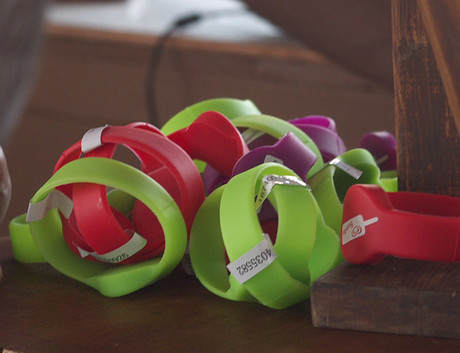3D printed 'battery' can be worn on your wrist

Scientists from Brunel University London have used a 3D printer to create a flexible, wearable equivalent of a battery. Claimed to be a world first, their technique opens the way for novel designs for super-efficient, wearable power for phones, electric cars, medical implants and more.
Described in the journal Materials Science and Engineering: B, the method relies on the printer squirting stacks of silicone, glue and gel electrolyte pastes like a layer cake, to make what looks like a clear festival wristband. Sandwiched inside is a supercapacitor, which stores energy like a battery, but on its surface and without chemical reactions.
“This is the first time a flexible supercapacitor including all its components has been produced by 3D printing,” said Milad Areir, a co-author on the study. “The most popular way to produce them is screen printing, but with that you can’t print the frame of the supercapacitor on silicone.”
While other researchers have found ways to make flexible supercapacitors, their techniques are typically expensive, relying on 3D laser selective melting machines and using different machines to print different parts. By contrast, the Brunel method uses a simple open-source printer connected by USB to a syringe driver with a stopper motor to print the paste layers, with only three or four syringes based on the size of the supercapacitor.
“Our technique brings it all together into one process with one machine,” said Areir. “It will definitely save time and costs on expensive materials.”

The work shows the power wristband can be made using cheap products from a household shop, rather than expensive metals or semiconductors. They have also been shown to stand up to stress tests without losing power.
“This study has … developed a novel 3D printing method for manufacturing flexible supercapacitors, by one single continuous process and using low-cost flexible silicone structural materials that are compatible with the electrode, current collector and electrolyte materials,” the researchers wrote.
The process is easy to copy, according to the study authors, and shows 3D printing using paste extrusion can be used to develop more sophisticated electronic devices with different mixes of paste. And while the wristbands are currently printed in a honeycomb pattern, which makes them quick to make, designers can also experiment with different complex shapes.

“In future it can be used for mobile phones,” said Areir. “For example, if the phone battery is dead, you could plug the phone into the supercapacitor wristband and it could act as a booster pack, providing enough power to get to the next charging point.”
3D semiconductor chip alignment boosts performance
Researchers have developed an ultra-precise method to align 3D semiconductor chips using lasers...
Researchers achieve 8 W output from optical parametric oscillator
Researchers have demonstrated a total output power of 8 W from a high-power mid-infrared cadmium...
"Dualtronic" chip for integrated electronics and photonics
Cornell researchers have developed a dual-sided chip known as a "dualtronic" chip that...






